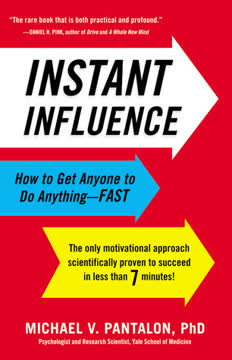Key Takeaways
1. The Flaw of "Tell and Sell" Motivation
Three decades of scientific evidence clearly demonstrate that tell-and-sell methods not only fail to motivate; they also lower the motivation level.
Traditional approaches fail. Most people instinctively try to motivate others using a "tell-and-sell" approach: explaining their reasons for a desired change and then trying to convince the other person. This method, however, is largely ineffective because people act on their own reasons, not someone else's. When you try to sell your reasons, the other person might agree but won't feel compelled to act.
Counterproductive results. Not only does "tell-and-sell" often go nowhere, but it can also actively reduce the other person's motivation. For example, telling a friend to exercise for health benefits, or suggesting they hire a trainer, often leads to excuses or polite dismissal. The desire to act must come from within, and external pressure can create resistance.
The core problem. The fundamental issue is that people don't care about your reasons for their change. They need to discover and personalize their own reasons. Until they understand their "why," the "how" (e.g., hiring a trainer) is irrelevant and will not spark action.
2. Instant Influence: Unlocking Inner Drive
The secret of Instant Influence is that it helps people discover their own reasons for doing something, even something they thought they didn’t want to do.
A proven method. Instant Influence is a scientifically validated six-step method designed to motivate people in seven minutes or less. Developed at Yale for emergency room doctors to inspire patients to seek help for alcohol problems, it works by encouraging individuals to find their own compelling reasons for action. This approach has achieved remarkable results, such as a nearly 50% reduction in drinking among "alcohol-involved" patients.
Universal applicability. This technique is effective across diverse settings and with various individuals, from resistant teenagers to highly motivated CEOs. It has been successfully applied in:
- Emergency rooms and trauma units
- Probation and parole systems
- Corporate training (Bayer, GE, Bristol-Myers Squibb)
- Universities (Yale, Harvard, Brown)
- Personal coaching and therapy
The "why" is paramount. The core principle is simple: people act for their own reasons. Instead of telling them why they should change, you ask them why they might want to change. This subtle shift empowers them to tap into their intrinsic motivation, leading to lasting behavioral change.
3. The Six Questions to Spark Change
You help people not by telling them why they should change but, rather, by asking them why they might want to change.
The core framework. Instant Influence is built around six simple, yet powerful, questions designed to guide individuals to their own motivations. These questions are:
- Why might you change? (Or, why might I change?)
- How ready are you to change—on a scale from 1 to 10?
- Why didn’t you pick a lower number? (Or, what would it take for that 1 to turn into a 2?)
- Imagine you’ve changed. What would the positive outcomes be?
- Why are those outcomes important to you?
- What’s the next step, if any?
Tailoring the language. The questions can be adapted to fit the specific situation and individual, making them more colloquial or direct as needed. The key is to maintain the underlying intent of each step, focusing on the influencee's perspective and autonomy.
Unlocking personal reasons. The sequence of questions is designed to progressively deepen the individual's self-reflection. From initial consideration (Step 1) to identifying personal importance (Step 5), the process helps uncover deeply held, often surprising, reasons that truly drive action.
4. Autonomy: The Foundation of Influence
If someone tells you to do something, you probably won’t feel like doing it, even if you might otherwise have wanted to.
Psychological reactance. The first principle of Instant Influence is that "no one absolutely has to do anything; the choice is always yours." This is based on the law of psychological reactance: people resist being told what to do, even if it's something they might benefit from. The harder you push, the more they resist.
Empowering choice. Reinforcing an individual's autonomy is crucial for the Instant Influence process to work. By explicitly stating that the decision is theirs, you disarm their natural resistance and create an open space for them to explore their own motivations. This can be challenging, especially when you feel responsible for their actions, but it's essential.
Practical reinforcement. To restore autonomy, use statements like:
- "This is your choice, not mine."
- "You're free to do whatever you want."
- "Only you can decide what you want to do. Of course, your choice will have consequences. But it's still your choice to make."
Acknowledging their perspective, even if you disagree, and being honest about your own agenda while emphasizing their ultimate control, paves the way for genuine engagement.
5. Motivation Resides Within Everyone
Everyone already has enough motivation.
Intrinsic drive. The second principle of Instant Influence posits that everyone already possesses sufficient motivation. This concept, sometimes called the "green principle" or "sustainable motivation," suggests that motivation is an internal, organic force, not something that needs to be imposed externally.
Small sparks matter. While some individuals exhibit extraordinary levels of motivation, most people operate with smaller, more subtle sparks. The method recognizes that even tiny amounts of motivation are enough to initiate change. A journey of a thousand miles begins with a single step, and finding the motivation for that small beginning is often all that's needed.
Beyond external rewards. Research consistently shows that intrinsic motivation—acting for one's own sake and satisfaction—is far more powerful and sustainable than extrinsic factors like threats, promises, or financial rewards. In fact, external rewards can sometimes decrease motivation for behaviors people were already doing. The goal is to mobilize motivation from within, not to bribe or coerce.
6. Focus on "Why," Not "How" or "Why Not"
People take action when they hear themselves say why they want to.
The power of "why." The core of Instant Influence is shifting the conversation from "how" to "why." When people focus on "how" to change, they often get stuck on obstacles and perceived difficulties. Asking "why" they might want to change, however, helps them connect with their desires and find their own reasons for action.
Avoid negative framing. Questions that focus on "why not" or "what's getting in your way" tend to reinforce resistance and make obstacles seem larger. Instead, use positive framing, asking about the potential benefits or upsides of making a change. For example, instead of "Why don't you exercise?", ask "Why might you want to exercise?"
Reflecting motivation. When listening, actively reflect back even the tiniest sparks of motivation you hear, while paradoxically acknowledging resistance. For instance, if someone says, "I should quit smoking, but I don't have the willpower," you might reflect, "You feel frustrated, but you'd also like to be able to stop." Always end your reflection on the motivational aspect, as people tend to remember the last thing they hear.
7. The Power of Small Steps and "Maybe"
Hospitalized patients who wrote that they would definitely attend follow-up appointments at an outpatient clinic once they were discharged from the hospital were just as likely to blow off the appointment as the people who wrote that they definitely would not go. Who was most likely to show up? The ones who wrote that they might go.
Embrace ambivalence. Counterintuitively, a "maybe" response can be more powerful than a "yes." When someone says "maybe," it indicates genuine internal conflict and an openness to possibility, rather than a firm commitment that might be easily broken or a flat refusal. This ambivalence provides fertile ground for exploration.
Baby steps for momentum. To overcome inertia, focus on the smallest possible action. Instead of aiming for a grand, overwhelming goal, break it down into a tiny, non-threatening first step. For example, instead of "exercise for 30 minutes," try "lay out my exercise clothes." This makes the task feel manageable and increases the likelihood of getting started.
The "Dead Man's Rule." Ensure your target behavior is active, not passive. Don't ask someone to "not drink" or "stop procrastinating" (a dead man can do that). Instead, focus on what they will do, like "refuse the next drink" or "spend 10 minutes browsing job sites." This active framing empowers the individual and builds momentum.
8. Self-Influence: Applying the Method Internally
You can use the Instant Influence technique on yourself as easily as you can use it on someone else.
Internal application. The Instant Influence method is equally effective for self-motivation. By asking yourself the six questions, you can uncover your own hidden reasons for pursuing a goal, even if you've been procrastinating or feeling stuck. The process helps bypass internal resistance and self-sabotage.
Surprising discoveries. Often, the true motivations for personal change are unexpected. For example, a writer struggling with procrastination found her real motive was "revenge" against a difficult client, which surprisingly spurred her to action. Be open to these surprising insights, as they often hold the most power.
Practical tips for self-influence:
- Write it down: Physically writing answers can evoke deeper thoughts and feelings than just thinking.
- Start small: Break down daunting tasks into tiny, safe, visualizable steps (e.g., "google job descriptions" instead of "hire an assistant").
- Ignore "hows" and "why nots": Focus solely on "why" you want something, even if it seems unrealistic initially.
- Expect to be carried away: The smallest step can create momentum, leading to unexpected progress.
9. Transforming Resistance into Action
But I promise you that Instant Influence works, very nearly 100 percent of the time.
The "impossible" cases. Instant Influence is particularly powerful with highly resistant individuals, even those who seem adamant in their refusal to change. The author's experience with his lifelong smoker father, who initially refused to even discuss quitting, demonstrates how the method can uncover deep, personal motivations (like spending time with grandsons) that lead to significant change.
Finding the spark. With resistant people, the key is to find the "tiny opening" in their refusal. A statement like "You know how hard it is to stop these things?" can be reframed as "You would quit if you could; it's just hard." This acknowledges their struggle while subtly reflecting their underlying desire for change.
Navigating pushback. Resistant individuals often test boundaries, express confusion, or try to shift responsibility. It's crucial to:
- Be patient and persistent: Repeat questions calmly, rephrasing as needed.
- Maintain autonomy: Continuously remind them the choice is theirs.
- Reflect, don't argue: Acknowledge their resistance and emotions without agreeing or getting defensive.
- Anticipate criticism: Be prepared for them to claim the idea as their own or even criticize you, as a way to regain control.
10. Influencing Strangers for Mutual Benefit
It’s remarkable how many different ways Instant Influence can be used!
Beyond personal relationships. Instant Influence is effective even with strangers, such as customer service representatives, salespersons, or service personnel. The core principles remain the same: reinforce their autonomy and help them find their personal reasons for helping you, even if those reasons are simply their desire to do a good job or help people.
Adapting for brevity. With strangers, you often have limited time. Focus on:
- Reinforcing autonomy immediately: Acknowledge their constraints ("I know you have rules to follow") and express appreciation.
- Focusing on "why" they might help you: "Why might you want to take the late charge off my credit card?"
- Skipping steps if necessary: Sometimes, just Steps 1 and 6 are enough to prompt action.
Overcoming common hurdles. Strangers often operate from scripts or a sense of entitlement from customers. Your approach should be:
- Patient and persistent: Be prepared to repeat Step 1 multiple times.
- Detached from power struggles: Your goal is to get what you want, not to prove a point.
- Focus on behavior, not attitude: You can't change their attitude, but you can influence their actions.
11. Action Plans: From Intention to Implementation
An action plan is a personal contract, written or oral, that lays out exactly what actions the influencee commits to.
Formalizing commitment. Once an individual expresses strong commitment talk (a clear intention to change with personal reasons) or reasons talk with strong emotion, they are ready for an action plan. This plan is a personal contract, making them accountable to themselves, not to you.
Key elements of an action plan:
- Clear behavioral goal: Specific and measurable (e.g., "Reply to every e-mail within 24 hours").
- Single next step: Focus on one manageable action.
- Time frame: Short-term, ideally 1-30 days.
- Method: How the goal will be achieved (e.g., "I'll put aside 15 minutes daily").
- Reasons: At least one, ideally 2-3, heartfelt and personal "whys."
- Optional: Obstacles, expected help, backup plan.
Timing is crucial. Do not create an action plan prematurely. If the individual is not genuinely ready, forcing a plan can make their accessed motivation disappear. If they're not ready, simply leave the door open for future conversation.
12. Active Acceptance When Change Doesn't Happen
Active acceptance doesn’t mean that you have to like what you’re accepting, or that you have to agree with it, or even that you have to think it’s for the best. It simply means that you understand that you’ve reached the limit, at least for the time being, of what you’re able or willing to do about a situation.
Coping with non-change. Despite best efforts, sometimes change doesn't happen. This can be frustrating, but it's crucial to practice "active acceptance" rather than passive resignation. Active acceptance means acknowledging the limits of your control and understanding that you've done your part.
Self-reflection and forgiveness. If change doesn't occur, reflect on your role: Did you reinforce autonomy? Did you focus on "why" over "how"? Did you avoid "tell-and-sell"? Forgive yourself for not having complete control. You can always try again, starting with an apology for past missteps.
Benefits of active acceptance:
- Release from burden: You are not responsible for another's choices.
- Potential for future change: Backing off can end power struggles, allowing the other person to find their own motivation later.
- Personal growth: You learn about your own limits and adapt your approach.
Even if the outcome is not what you desired, the process of attempting Instant Influence and then actively accepting the result is a valuable exercise in effective communication and personal growth.
Last updated:
Review Summary
Instant Influence receives mixed reviews, with an average rating of 3.92 out of 5. Many readers find the six-step process for motivating others and oneself useful, praising its effectiveness in various situations. The book's repetitive nature is both appreciated for reinforcing concepts and criticized for being excessive. Some readers express skepticism about the method's universal applicability but acknowledge its potential benefits. The book is commended for its practical approach to influence and motivation, though some find the formulaic questioning awkward or manipulative.
Similar Books
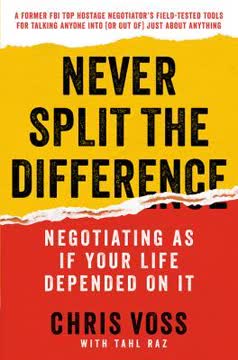


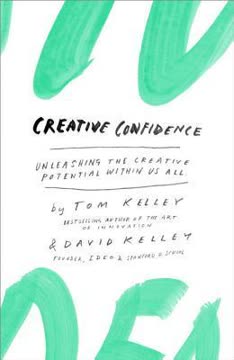
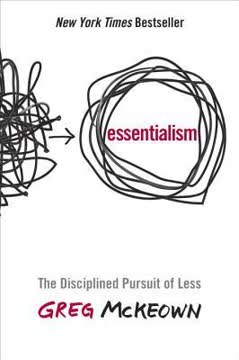

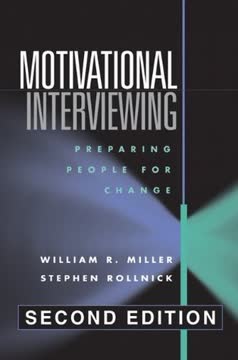

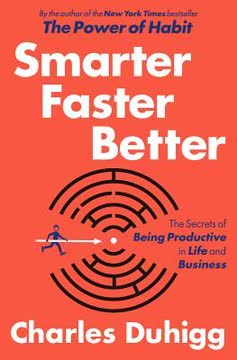
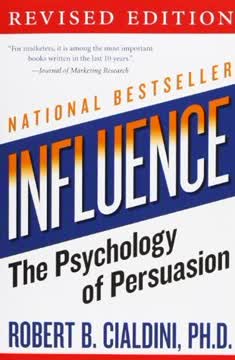
Download PDF
Download EPUB
.epub digital book format is ideal for reading ebooks on phones, tablets, and e-readers.
